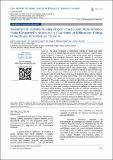| dc.contributor.author | Lazaro Bulili, Marco | |
| dc.contributor.author | Nyagero, Josephat | |
| dc.contributor.author | Kibusi, Stephen Mathew | |
| dc.contributor.author | Boruett, Norbert | |
| dc.date.accessioned | 2022-03-01T13:15:43Z | |
| dc.date.available | 2022-03-01T13:15:43Z | |
| dc.date.issued | 2022-02 | |
| dc.identifier.citation | Marco Lazaro Bulili, Dr. Josephat Nyagero, Dr. Stephen Mathew Kibusi, Mr. Norbert Boruett (2022). Assessment of Diploma Nursing Program Curriculum Implementation Using Kirkpatrick’s Approach: A Case Study at Kilimanjaro College of Health and Allied Science-Tanzania. East African Scholars J Edu Humanit Lit, 5(2), 50-56. | en_US |
| dc.identifier.issn | Print 2617-443X | |
| dc.identifier.issn | Online 2617-7250 | |
| dc.identifier.uri | https://repository.amref.ac.ke/handle/123456789/601 | |
| dc.description.abstract | The study conducted at Kilimanjaro College of Health and Allied Science-Tanzania, to assess Diploma nursing program curriculum implementation using Kirkpatrick’s approach. The four levels of the model used in assessment. Microteaching steps examined classroom nurse tutors behavior of curriculum implementation process. Aimed to assess how CBET implemented, as since inception in 2008 not assessed and that if, Microteaching technique adhered to in the process besides if implementers has regulatory qualities and experience to the implementation. These help to identify gaps of the implemented curriculum besides the way forward to the solution. Census used with the study. A descriptive cross-sectional design of both quantitative and qualitative methods of data collection used. Scaled Likert’s questionnaire following the model, face-to-face interview along with observation used as tools. Nurse tutors was the treatment group whereas students were the control group and tested concurrently. SPSS v20 analyzed the model; paired sample t-test tested the performance significance whereas eta- squared evaluated it. The results between pre (M=3.36, SD=2.69) and post-test [M=6.44, SD=2.64, t (305) =20.671 p< .001 indicated significant increase in performance. The eta squared statistics evaluation of 0.58 indicated a large effect size change. From the study, tutors were committed, had enough knowledge and experience with curriculum implementation. Nevertheless, they are not sufficient compared to the modules taught. Observed major and minor errors in the study, need rectification. Therefore; Kirkpatrick’s model of assessment and Microteaching skills are innovations to measure medical education competences, need campaigns. My opinion, tutors roles need promotions moreover re-defined for awareness. | en_US |
| dc.description.sponsorship | Copyright © 2022 The Author(s): This is an open-access article distributed under the terms of the Creative Commons Attribution 4.0 International License (CC BY-NC 4.0) which permits unrestricted use, distribution, and reproduction in any medium for non-commercial use provided the original author and source are credited. | en_US |
| dc.language.iso | en | en_US |
| dc.publisher | East African Scholars Publisher | en_US |
| dc.subject | Assessment | en_US |
| dc.subject | Competence | en_US |
| dc.subject | Curriculum | en_US |
| dc.subject | General Nursing | en_US |
| dc.subject | Kirkpatrick’s approach | en_US |
| dc.subject | Learning and teaching | en_US |
| dc.subject | Microteaching | en_US |
| dc.title | Assessment of Diploma Nursing Program Curriculum Implementation Using Kirkpatrick’s Approach_A Case Study at Kilimanjaro College of Health and Allied Science-Tanzania | en_US |
| dc.type | Article, Journal | en_US |

